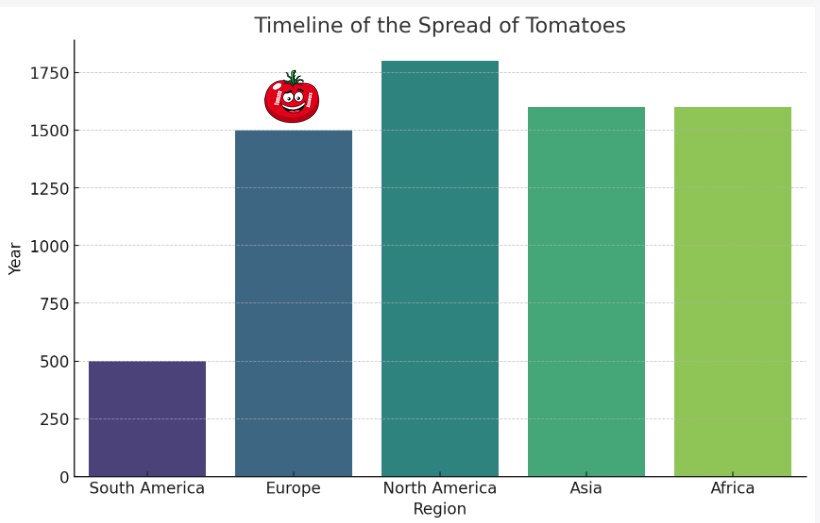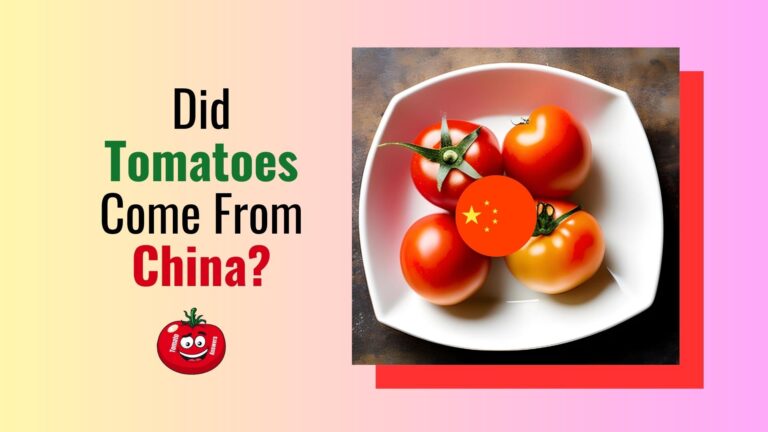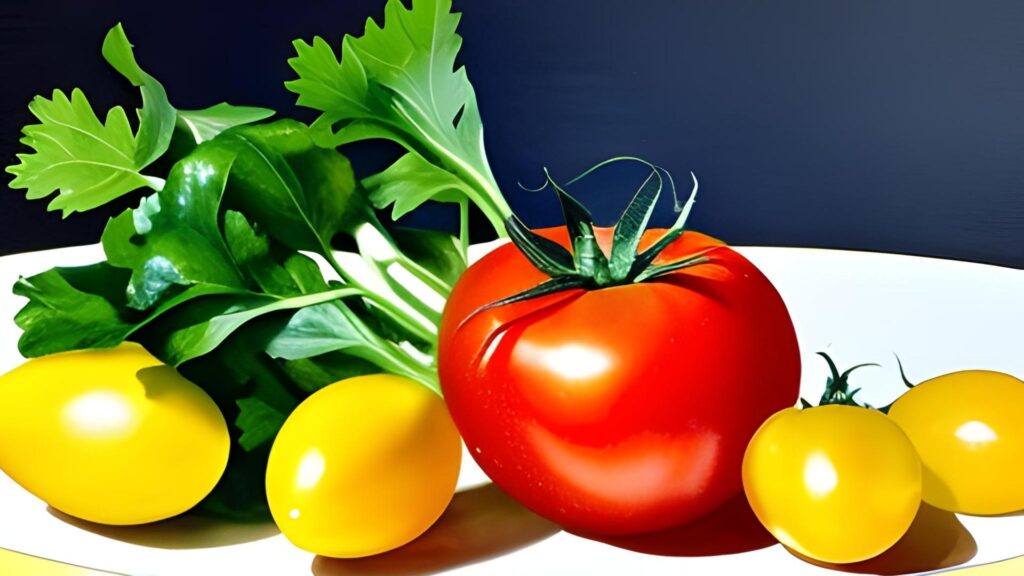In This Article
Did Tomatoes Come From China? Uncovering Their Origin
Tomatoes are a staple in many cuisines worldwide, from a classic Italian marinara sauce to a refreshing Greek salad. But where did these juicy, red fruits come from, and did they originate in China, as some claim?
To answer this question, we must first explore the history of tomatoes. It is believed that the Aztecs first cultivated tomatoes in Mexico over 2,000 years ago.
They were then introduced to Europe by Spanish explorers in the 16th century. From there, they spread worldwide and became a popular ingredient in many dishes.
The Geographical Roots of Tomatoes
Tomatoes are native to the western side of South America, specifically in the Andean region. Dating back to 500 BCE, they were first cultivated in modern-day Peru and Ecuador. The tomato was initially used for ornamental and medicinal purposes, and it was not until much later that it found its way into the world’s kitchens.
Tomatoes were introduced to Europeans thanks to the Spanish colonization of South America in the 16th century. They were initially viewed suspiciously due to their relation to the poisonous nightshade family. Still, their arrival in Europe marked the beginnings of a global love affair with the juicy, red fruit.
From Europe, tomatoes spread globally, particularly to areas with similar climates to their native Andes. They were first introduced to North America in the early 1800s and quickly became popular in the southern United States. Today, tomatoes are grown and consumed worldwide and are an essential ingredient in many global cuisines.
The Role of Italy in Tomato Cultivation
While the tomato did not originate in Italy, the nation is responsible for its popularity. Italian cuisine heavily relies on tomatoes, and the country is known for its delicious tomato-based dishes, including pizza and pasta sauces.
Interestingly, tomatoes were initially met with skepticism in Italy. It was believed that they were unhealthy and possibly even poisonous. However, the 19th century saw a significant shift in the public perception of tomatoes, and they quickly became a staple in Italian cooking.
The Spread of Tomatoes to Asia and Africa

Portuguese traders introduced Tomatoes to Asia and Africa in the late 16th century. They were also initially viewed with suspicion in these regions, and it took several centuries for them to become popular ingredients in local cuisines.
In China, tomatoes did not become widely consumed until the 20th century. Today, China is one of the largest producers of tomatoes in the world, with millions of tons grown each year. Despite this, the debate over whether or not tomatoes originated in China continues to this day.
The journey of tomatoes from their humble beginnings in the Andes to their place on dinner plates across the globe is fascinating. Their history is a testament to the power of globalization and the interconnectedness of our world.
The Historical Journey of Tomatoes
Tomatoes have a rich history that spans back hundreds of years. Originally grown in regions of South America, they were first cultivated by the Incas and other indigenous people of the Andes Mountains. The Aztecs also grew tomatoes in Mexico, where they were known as “xitomatl.”
When the Spanish conquered Mexico in the 16th century, they introduced tomatoes to Europe. At first, people were skeptical of the fruit’s unusual appearance and thought it might be poisonous. However, by the 18th century, tomatoes had gained popularity in Europe and were widely cultivated.
Tomatoes were also brought to North America by European colonizers. By the mid-1800s, tomatoes had become a staple crop in the United States and were used in various dishes.
Tomato Varieties
Today, there are thousands of varieties of tomatoes available. Some common types include:
- Beefsteak tomatoes, which are large and meaty, with a sweet taste.
- Roma tomatoes, which are oblong and commonly used in sauces and pastes.
- Cherry tomatoes are small and sweet, often used in salads and as a snack.
There are also heirloom varieties, which are typically older, open-pollinated breeds that have been passed down through generations. These tomatoes often have unique colors, shapes, and flavors.
In different cultures throughout history, tomatoes have been used in various ways. In Italy, they are a main ingredient in pizza and pasta dishes.
In Mexico, they are used in salsa and guacamole. And in the United States, they are used in everything from ketchup to Bloody Marys.
Tomatoes and China
There has long been speculation that tomatoes originated in China. However, there is no definitive evidence to support this claim. Historians and botanists agree that tomatoes are native to South America.
While it is true that tomatoes were introduced to China relatively early in their history, it is unlikely that they were originally from there.
The Chinese were known to have trade relations with South America as early as the 16th century, and it was likely through these trade routes that tomatoes were brought to China.
Despite this, many varieties of tomatoes are native to China, including the “Xinjiang Cherry” tomato and the “Hongxiang” cherry tomato. These tomatoes are still widely grown and consumed in China today.
Tomatoes and Traditional Chinese Medicine
- In traditional Chinese medicine, tomatoes have been used for various health purposes.
- They are believed to have cooling properties and are often recommended to combat heat-related illnesses such as dehydration and heatstroke.
- Tomatoes are also useful in treating digestive issues and promoting blood circulation.
Tomatoes in Modern Chinese Cuisine
Today, tomatoes are a staple in many Chinese dishes, especially in Sichuan. They are often used in soups, stews, and stir-fry dishes and are prized for their sweet and tangy flavor. One of the most famous Sichuan dishes, “stir-fried tomatoes and eggs,” features tomatoes as the star ingredient.
While no concrete evidence exists that tomatoes originally came from China, their impact on Chinese cuisine and culture cannot be denied.
Tomato Farming and Cultivation
Tomatoes are one of the most commonly grown vegetables in the world and are widely used in various dishes and products. They are relatively easy to grow and can be cultivated in various environments, from small backyard gardens to large commercial farms.
Popular Types Of Tomatoes In China
Here are 5 popular types of tomatoes commonly grown and consumed in China:
1. Jinpeng Tomato
This oval-shaped pink tomato has thin skin, few seeds, high sugar content, and a well-balanced flavor. It is juicy and typically weighs around 100-200g. Jinpeng is a very widely grown greenhouse tomato variety in China.
2. Red Crown Tomato
A medium-sized round tomato with vibrant red color and a sweet taste. Red Crown has a meaty texture with few seeds and averages 150-180g in weight. It is suitable for greenhouses and open fields.
3. Hezuo Tomato
Named after the Hezuo region, this tomato variety is plump and round and weighs 220-350g on average. It has high sugar levels, dense flesh, and a balanced sweet and sour taste. Hezuo tomato grows well in provinces like Gansu, Ningxia, and Inner Mongolia.
4. Beijing Xiaohong Tomato
A cherry tomato cultivar that is smaller in size at around 30-50g per fruit. Beijing Xiaohong is sweeter than regular cherry tomatoes and bursts with flavor. It thrives in greenhouse cultivation in northern regions.
5. Yali Pear Tomato
This distinct elongated, pear-shaped tomato has a protruding nipple on the bottom. It is bright red with a sweet taste balanced by some tartness. Yali pears weigh approximately 150-250g each. They grow well in Sichuan province.
Many different types of tomatoes are available, each with unique flavor and characteristics. The most common types include beefsteak, cherry, Roma, and heirloom tomatoes. Each variety has its own ideal growing conditions and is used in different ways in cooking and food production.
Tomato Cultivation
Tomatoes are typically grown from seed and require well-drained soil and a lot of sunlight. They can be grown indoors and outdoors and require regular watering and fertilization.
Many farmers use organic farming practices to cultivate their tomatoes, which can help to maintain soil health and reduce environmental impact.
Tomatoes can be harvested when fully ripe or left on the vine to mature further. They are typically harvested by hand and are then sorted and packed for transportation to markets and production facilities.
Tomato Production and Uses
- Tomatoes are used in various food products, from sauces and soups to salads and sandwiches. They are also used to produce ketchup, salsa, and other condiments.
- Tomatoes are rich in vitamin C and lycopene, important nutrients for maintaining good health.
- The tomato is also an important crop for many farmers worldwide, with the global tomato market valued at over $60 billion annually.
- Countries such as China, India, and the United States are the largest producers of tomatoes, with many small farmers also growing them for local markets.
Fun Facts About Tomatoes
Tomatoes are more than just a versatile ingredient in the kitchen. Here are some fun facts about these juicy fruits:
- Tomatoes are fruits, not vegetables: Despite being commonly referred to as a vegetable, tomatoes are technically classified as a fruit because they develop from a flower’s ovary.
- Tomatoes were once thought to be poisonous: Because tomatoes belong to the same family as deadly nightshade, many people used to think they were toxic. It wasn’t until the 1800s that tomatoes gained widespread acceptance as a food.
- Tomatoes are a great source of nutrition: Tomatoes are low in calories and high in vitamins A and C, potassium, and lycopene—a powerful antioxidant linked to a reduced risk of certain types of cancer.
- Tomatoes are used in medicine: The antioxidant properties of lycopene make tomatoes a popular ingredient in natural remedies and supplements for heart disease, cancer, and other health conditions.
- Tomahto or tomato? Depending on where you’re from, you might pronounce tomato differently. In the United States and Canada, it’s generally pronounced “toe-may-toe,” In the UK and Australia, it’s more commonly pronounced “toh-mah-toh.”
- Ketchup wasn’t always made with tomatoes: The original ketchup was made with mushrooms, walnuts, or anchovies. It wasn’t until the 1800s that tomatoes were used to make ketchup.
So the next time you slice up a tomato for your salad or sandwich, remember all the interesting facts that make this humble fruit much more than just a kitchen staple.
FAQs about Did Tomatoes Come From China?
In this section, we will answer some frequently asked questions about tomatoes.
Where did tomatoes originally come from?
Tomatoes originated in South America, specifically in modern-day Peru, Bolivia, and Ecuador.
Did tomatoes come from China?
While tomatoes did not originate in China, they have been grown and consumed for centuries.
What are some popular varieties of tomatoes?
Some popular varieties of tomatoes include Beefsteak, Roma, Cherry, and Heirloom.
How are tomatoes typically farmed and cultivated?
Tomatoes are typically grown as annual plants and require moist soil, full sun, and warm temperatures to thrive. They are often grown in greenhouses or fields with support structures such as cages or trellises.
What are some common dishes that feature tomatoes?
Some common dishes that feature tomatoes include pizza, spaghetti and meatballs, salsa, and caprese salad.
Are there any health benefits to eating tomatoes?
Yes, tomatoes are a good source of vitamins A and C, potassium, and fiber. They also contain lycopene, which has been linked to a reduced risk of certain types of cancer.
Are there any downsides to consuming tomatoes?
While tomatoes are generally considered healthy, some people may experience allergic reactions or digestive issues after consuming them.
Additionally, some tomato varieties may be high in sugar or sodium if served in processed or canned forms.
Are You New To Tomato Answers?
If you are new to Tomato Answers, here are a few resources to help you:
- Living in Oklahoma and planning your tomato garden? Learn When to Plant Tomatoes in Oklahoma.
- Not sure about the best time to plant in Indiana? Discover When to Plant Tomatoes in Indiana.
- Planning your tomato garden in Iowa? Find out When to Plant Tomatoes in Iowa.
- Looking to grow tomatoes in the beautiful state of Colorado? Learn When to Plant Tomatoes in Colorado.
- Planting tomatoes in the sunny state of Florida? Here’s When to Plant Tomatoes in Florida.
- Planting tomatoes in the vast lands of Alaska? Learn When to Plant Tomatoes in Alaska.


